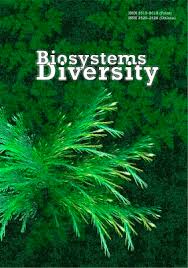Soluble cuticular wax composition and antimicrobial activity of the fruits of Chaenomeles species and an interspecific hybrid
Soluble cuticular wax composition and antimicrobial activity of the fruits of Chaenomeles species and an interspecific hybrid
Author(s): Y. V. Lykholat, N. O. Khromykh, O. O. Didur, S. I. Okovytyy, T. V. Sklyar, V. R. Davydov, T. Y. Lykholat, I. N. KovalenkoSubject(s): Agriculture, Energy and Environmental Studies, Regional Geography
Published by: Дніпропетровський національний університет імені Олеся Гончара
Keywords: Chaenomeles japonica; Chaenomeles speciosa; Chaenomeles × superba; fruits; cuticular wax; fatty acids; aldehydes; alkanes; antimicrobial ability;
Summary/Abstract: Plants of the genus Chaenomeles Lindl. (Rosaceae) naturally grow in Southeast Asia and represent the richest resource of biologically active compounds with beneficial properties for humans. Plants of C. japonica (Thunb.) Lindl. and C. speciosa (Sweet) Nakai species, and interspecific hybrid C. × superba (Frahm) Rehder (C. japonica × C. speciosa, Superba group) have been successfully introduced in the steppe zone of Ukraine and bear fruits. In this study, we evaluated chemical composition of fruit cuticular waxes and antimicrobial activity of fruit extracts. The soluble waxes were characterized using gas chromatography-mass spectrometry (GC-MS), and 26–36 compounds, representing 91.7–96.6% of the total soluble cuticular waxes, were identified. Waxes of Chaenomeles fruits belonged to six classes, namely fatty acids, alcohols, aldehydes, esters, ethers and alkanes. Aldehydes 7-hexadecenal and heptacosanal, and alkanes hexatriacontane and tetrapentacontane were the main constituents in the soluble cuticular waxes of C. speciosa and C. × superba fruits, accounting for more than half of the total contents. However, alkane tetrapentacontane, alcohol 8,10-hexadecadien-1-ol and heptacosanal prevailed in C. japonica fruit waxes. Isopropanolic fruit extracts exhibited dose-dependent antimicrobial activity against four Gram-negative bacteria, five Gram-positive bacteria and one fungal strain in the disc diffusion assay. In general, extracts from the Chaenomeles fruits demonstrated higher activity against Gram+ bacteria than Gram- strains. The strongest inhibiting activity was shown against Staphylococcus epidermidis (by the fruit extracts of C. × superba and C. speciosa), Micrococcus lysodeikticus and Candida albicans (both by C. × superba fruit extract). Results of the study confirmed accumulation of the bioactive compounds in the fruit waxes of different Chaenomeles species and antimicrobial ability of Chaenomeles fruits as well. These findings revealed the bioactive compounds in fruit cuticular waxes and suggested health-promoting properties of introduced Chaenomeles species.
Journal: Biosystems Diversity
- Issue Year: 29/2021
- Issue No: 4
- Page Range: 334-339
- Page Count: 6
- Language: English

